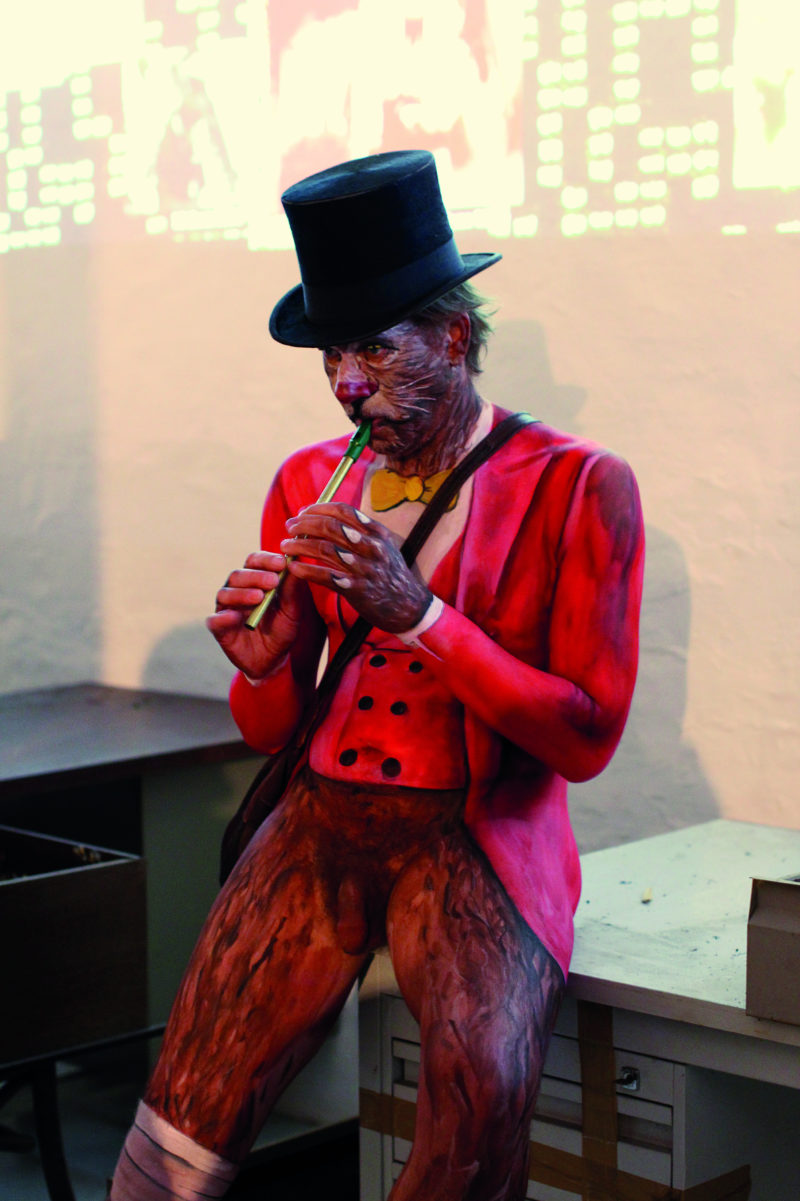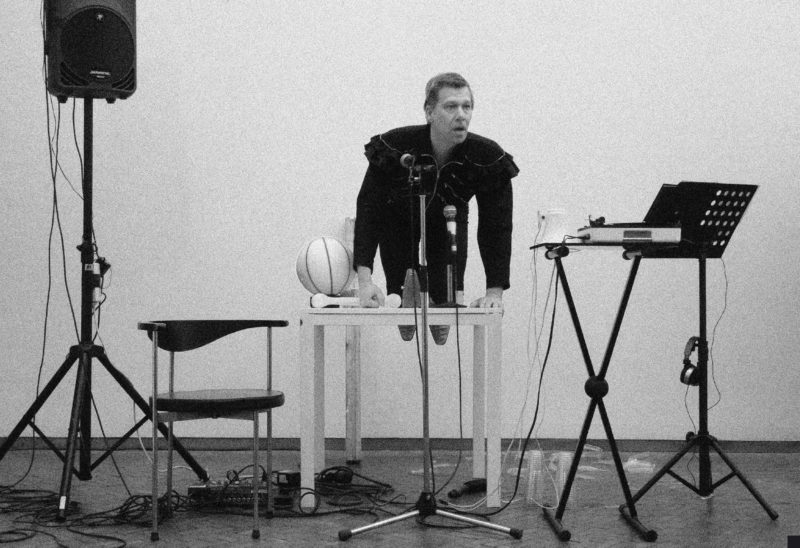Peter Fengler

Henry Andersen
Somehow, given the context of this interview, I wanted to think about the kinds of ties and communities that exist between your work and the people around you. For me, the Avant Guardian should exist as a kind of document of what is happening in a certain scene of music-making rather than as only a way to promote concerts or sell KRAAK records. I wanted to start then, by asking you how the scene was when you first began making performances. How was it that you got involved in this kind of performance making – through seeing live performances? listening to records?
Peter Fengler
Dear Henry,
Until 20, I was pretty much a virgin art-wise. Meaning I had no idea about this specific world and was just hanging around doing naughty things with friends and playing sports on a pretty high professional level. But doing steeple-chase on LSD makes things complicated, and finally after realising the rigidness of educational systems meant, for example, even the sports academy gets focused, the only possible escape to cling on to seemed suddenly, after some experiences, to be the arts.
So I got involved and was pretty soon in the turbulence of sub- and counterculture of the 80’s. Even so, I ended up at arts academy. But it was my direct surroundings not the institutionalised one that was most informative and influential. In a way performance was always something in me, in sports and also in arts. The group I operated in at that time was a multi-amorous scene where all kinds of cooperation manifested day by day. And of course there was the doing-it-all-by-yourself thing. Wanking, pranking. We mostly did everything on the borderlines.
HA
What were the venues for these kinds of performances at the time? How did you come to meet this community?
PF
This all happened in the beginning, mostly in my local surroundings. Slowly but surely, because of my art school background (which, to be clear, couldn’t at all handle performative matters or sound related freakshows at the time), I started with showing works, mostly paintings, on a national level. It went pretty well quickly; quite some shows and quite some money. Nevertheless, I was looking for more adventure than just hanging works. Soon my work became more and more 3D, 4D, etc. Paintings became objects, installations, and finally happenings with a variety of invited guest performers in complex installational settings. ‘The opening’ was what I was interested in.

HA
Since 2003, you’ve been running De Player in Rotterdam. Can you talk a little about this? – what it does and how it works. What made you want to begin running a space of your own?
PF
DE PLAYER is a club for peripheral artistic activities, a perfect continuation of this approach of making lively happenings instead of stiff drinking sessions at openings. Action man. Sweat, sex. That kind of smell. Finally, in most of the art world career is just connected with the capitalistic aspects of objects and all these diplomatic armies involved in them, and this wasn’t my goal. DE PLAYER was the opportunity to let these happenings take place more or less in my own studio. Bringing over spirits I thought were worthwhile to share with an exclusive and willing audience. For me, it meant I could take a break from the train of doing art shows all around and work intensively with a lot of people and materials on the spot. After something like 10 years of running around I wanted some reflection and this was the way to continue those happenings without staying in the circus of one specific part of the art world. We are not talking about getting out of it, but about working with different dynamics, different positions, different language.
HA
I read somewhere that at a certain point you were wanting to think of De Player as a kind of ‘body’ – do you still see it like this?
PF
It is, of course, a body. No need even to think about that. A polymorphic construction with a spirit in which all activities of the past, present and future are connected. It is not about programming in the perspective of cultural industries. It is carefully freaking out on substantial peripheral positions. It is a sort of a time-twisted vector that spirals forwards into the past, and backwards into the future. It emerges, almost automatically, as the present is torn tidally apart. It is another construction of time and works on a different notion of time, awareness and understanding the future. But not the future which is based on the linear structure of the time and progress, like the European futurists. That’s nothing more than remnants of Newtonian physics updated with some of Einstein’s relativity. So you should understand that the body is fluid and that there is neither backward nor forward.
HA
I wondered if you might talk about how DIY ethos plays into your practice, both in terms of your approach to your own work and to how you run De Player. Are the two approaches related?
PF
The DIY is already earlier mentioned in the wanking, pranking; very important. It is the starting point. In my particular case it is also based on some background trauma to do with my relationship with ‘the other’. You have to imagine how poly-amorous inflictions open the mind. It was well told to me that the basis is your own cock (in my case, at least). That’s where you are rooted with time-related phenomena and the characterisation of yourself as an entity. From there aesthetics, politics and ethical aspects give shape to the urge of activity.
HA
I’m interested in the way your records work too. A lot of them have very little to do with documenting or distributing your performances – that the records are cut on chocolate or tin foil so they break apart as soon as you start to play them. Can you talk a little about how you see the performances and the records as working together?
PF
My records are based on performative activities in the studio itself; a direct residue. The performances I do elsewhere in clubs, galleries etc. are primarily focusing on the situation at that very moment. Recording, in my point of view, is an impossible reproduction of that which happened at a certain moment in time. To capture that moment and communicate it via reproduction as a representation of what happened is a typical anti-neo approach. The timeline is not an erected figure. I mostly compare my studio-based activities to a complex architectural space in which the dust from former activities gets stuck on tape. Here too everything connects up as one body. It is not interesting or important to capture it all. Blind spots and wormholes are of great importance for real understanding.
It is very important to document and mediatise your own activities in order to play a temporary’ key role’ in artistic power fields which are industrialised and therefore material-centric. Nevertheless, for me, these are all complicated matters which I approach with ambiguity. I also could have become an accountant.
HA
Do you think of what you do with De Player as somehow linked to archiving or surveying? I’m thinking of something like this posthumous record of Sven Hanson you put out last year – where the label is not only related to a present community but has this reverence for the past as well. What do you think about bridging these two generations? About an idea of community that can be historical as well?
PF
The activities of DE PLAYER – the records, the live events, the publications – are all based on a surveying attitude which mostly reflects the process involved in our stage, productions and program. And the process is not related to one person or several separated persons. The process is an intermediate, linked, prop-based continuity of us, sub, fuzz, bizz, etc. Those manifestations are, for better or worse, a necessity to linger on. Working with living or dead people is all the same. It just smells different at certain angles. And again, time-wise we do it twisted anyway and are mostly linked to certain attitudes that were invented a long time ago. We are pretty much conservative.
HA
Finally, I wanted to ask about collaboration – you are (or were?) a part of Coolhaven, you work a lot with Dennis Tyfus and several other people. What role does collaboration play – both for yourself and in thinking about this idea of a community that we have been speaking about?
PF
Collaboration is a fundamental thing. One way or another. I don’t believe in the hard working monk nor in the incredibly talented individual. It is important to be involved in a network of information, chaos and meaning. Coolhaven, Tyfus, Ultra Hobby Complex, DE PLAYER, Stephan Bloth, VanKoffiecocks, School voor Nieuwe Mode, etc. All this is based on the fact that we spin each others qualities by putting together different mind settings and capacities. From there speculative aesthetics can draw paths toward ‘phenomenadelic’ variations where consistently stabilised ‘transcendentals’ become perturbed and malleable models, yawning those as-yet-unknown states of play. That’s about having a good time.